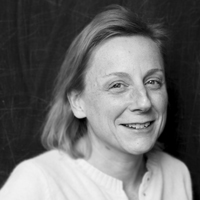A Conversation with Terry Schwarz
VPRN recently spoke with advisory board member Terry Schwarz about her work with Cleveland’s Urban Design Collaborative, passion for vacant properties, and plans to explore the space next to Ohio’s largest men’s emergency shelter. Below is an excerpt.
For Terry’s thoughts about Cleveland’s “gray” sewer infrastructure and how vacant property could have helped it to go green, click here to access a March 2014 article in the Cleveland Plain Dealer.
VPRN: Where did you get the idea for Pop Up City?
 Around 2007 we hosted a Phillipp Oswalt Shrinking Cities Exhibition. It was in Cleveland briefly between its more formal stops in Detroit and New York City. We found that when we had the exhibition here, people sort of looked at it, and, they thought it was interesting but people weren’t engaged in the issues. This was before the foreclosure crisis was as apparent as it is now. It was a time when people could still look at the Shrinking Cities Exhibition and say, “Well, wow, that’s too bad for Detroit” without ever making the leap that we had similar conditions in Cleveland.
Around 2007 we hosted a Phillipp Oswalt Shrinking Cities Exhibition. It was in Cleveland briefly between its more formal stops in Detroit and New York City. We found that when we had the exhibition here, people sort of looked at it, and, they thought it was interesting but people weren’t engaged in the issues. This was before the foreclosure crisis was as apparent as it is now. It was a time when people could still look at the Shrinking Cities Exhibition and say, “Well, wow, that’s too bad for Detroit” without ever making the leap that we had similar conditions in Cleveland.
In the show we staged some short-term interventions. What ended up happening was we discovered that people are much more receptive and open to talk about hard things if they do it in a way that’s unexpected and fun. We did a movie and music event in a vacant space/park in Slavic Village and it was such a nice moment that I ended up pursing funding from Spontaneous Interventions Lab to launch Pop Up City so we could do more of this, on-the-ground interaction.
Our goal here in Cleveland, why we started doing this, was to get other organizations and individuals really interested in activating the city. And whether it was a direct outcome of our work, or just something that was in the air, it definitely seems to be taking root.
VPRN: Will you replicate it?
If a project feels like something that we’re replicating, something that we’ve figured out once before, then it’s not an ideal project for us to do. We like to always be moving into areas that we haven’t encountered before. It’s fun. It’s uncomfortable. It’s labor intensive. It gives the opportunity to make mistakes, new ones, all over and over again.
VPRN: What’s happening in Cleveland?
It feels like in a lot of cities, de-populating cities, legacy cities, you’re getting these kind of dynamic downtown development environments. It’s true in Detroit. It’s true in Pittsburgh. It’s true in Cleveland and Philadelphia. So you have the strength of downtown and then nearby you have struggling neighborhoods. It’s almost like a tale of two cities. We’re working on this thriving part of the city at the same time that we’re trying to help communities cope with the disinvestment. By having a foot in both of those worlds, maybe we can find ways to help the thriving downtown actually begin to support what’s happening in some of the other neighborhoods.
VPRN: What’s on your pipeline for the rest of the year?
We’re working on a new initiative around people who are homeless, and understanding how the public realm could be adapted to both provide comfort and amenities to people who are outside during the day or the night. Rather than doing just short term temporary projects because they’re fun and they bring vitality to the neighborhood, we’re really trying to put these short term interventions into service.
We’re going to do some short-term projects in the part of Cleveland where there is a huge concentration of both homeless shelters and support agencies. Can we stage some short-term projects and learn from that process about how to adapt the public environment in order to both be more conducive to the needs of people who are homeless but also to reduce the friction between people who are homeless and those who aren’t. That friction is very real.
One project we’re doing around this issue is a public space next to the largest men’s shelter in Ohio. A second project is a street that during the daytime is a corridor where lots and lots of people hang out, and it makes a lot of people uncomfortable.
VPRN: What’s exciting to you about vacant properties?
Things are always changing. It’s the opportunity that vacancy represents, coping with outcomes of loss.
VPRN: What should be at the top of a research agenda about vacant property, if you were in charge of the world?
I’m never going to be in charge of the world. We’re really interested in thinking about vacant buildings. For many years, the emphasis has been on vacant land and the aftermath of demolition. But as we’re seeing more and more of the city being erased, it feels like there’s an urgent need to intervene, to be more strategic, and to make sure we’re not losing things we should really be holding onto.
We just launched a new design build studio with undergraduate students. We’re working on one house. We’re hoping to extract some new methods for creating value and making some of these houses desirable to markets that aren’t considering them.
VPRN: What book are you reading right now?
My daughter and I are going through the Lemony Snicket books. We’re on number 5. ♦
